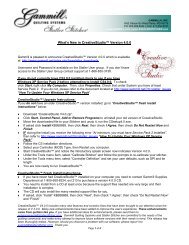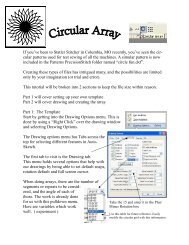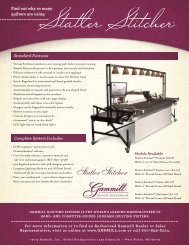Create successful ePaper yourself
Turn your PDF publications into a flip-book with our unique Google optimized e-Paper software.
Quilting the Quilt - Which CS Feature To use<br />
Phase 2 - Blocks<br />
Stitch Partial Patterns using Trim-Outside<br />
Tip: Be Patient! CS takes a little time before it moves to the<br />
beginning of the pattern and starts to quilt. CS needs to examine<br />
every TRIM boundary and identify where each additional tie-off<br />
goes.<br />
Be Patient when doing a restart too - it takes time.<br />
6. The sewing head will move to the Start of the pattern. CS will prompt for pulling up<br />
the bobbin thread and will begin stitching.<br />
The Trim function eliminated some of the pattern so tie-offs will be done at the<br />
beginning and end of each of the remaining pattern segments. To avoid thread<br />
breaks at these extra tie-offs, CS will finish a segment with a tie-off, and instead of<br />
moving directly to the beginning of the next segment it goes past about 1/4" and<br />
comes back to the correct spot. This pulls just enough extra thread to reduce the<br />
stress and prevent thread breaks when doing the next tie-off.<br />
At the end of the quilting sequence, you will be prompted to pull up the bobbin<br />
thread. It doesn't matter how the bobbin thread is pulled up, secured or trimmed.<br />
Just be sure to click OK because it completes this process.<br />
Tip: Multiple "Trim-Inside" boundaries are possible in one quilt<br />
group but only one "Trim-Outside".<br />
Quick Reference Trim Outside<br />
4.2.5 Stitch a Composite Pattern<br />
179<br />
Composite patterns can be created using any patterns but block patterns 65 and<br />
P2P patterns 66<br />
work best. Composite patterns are recommended when a block is<br />
large and needs more than one pattern to fill the space. Sometimes composite<br />
patterns are created to fit unusual shapes.<br />
Example 1: Simple patterns are often the best choice for quilts because they add<br />
curves and motion without detracting from the piecing. Large areas may need<br />
multiple copies to provide consistent density.<br />
Copyright © 2009 <strong>Gammill</strong>, Inc. | All Rights Reserved<br />
105





